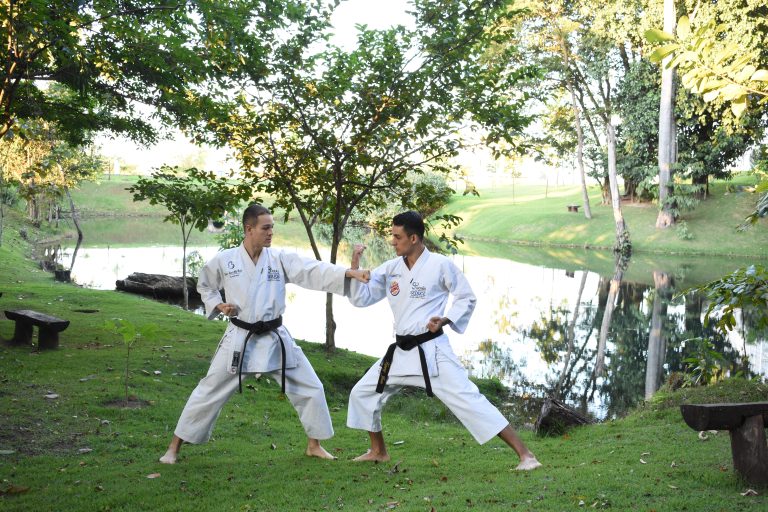Die Reihenfolge der Karategürtel in den USA
Karate ist eine Kampfkunst, die aufgrund ihrer Effektivität weltweit bekannt ist. Um die Fortschritte ihrer Schülerinnen und Schüler zu messen, haben Karatelehrerinnen und -lehrer eine Hierarchie von Gürteln eingeführt, um das Niveau jedes Einzelnen zu kennzeichnen. Diese Gürtel zeigen auch das Engagement einer Person für diese Disziplin. In den USA gibt es eine bestimmte Reihenfolge der Karategürtel, die wir in diesem Artikel näher erläutern werden.
Weißgurt (10. Kyu)
Der Weißgurt ist der Anfangsgurt im Karate. Es symbolisiert die Reinheit und das Streben nach Wissen. Die Schülerinnen und Schüler beginnen in der Regel im Alter von 5 bis 6 Jahren mit diesem Gurt und müssen eine grundlegende Kenntnis der Karatebewegungen und -techniken demonstrieren, um den nächsten Gurt zu erreichen.
Gelbgurt (9. Kyu)
Der Gelbgurt ist der zweite Gurt in der Reihenfolge, nachdem die Schülerinnen und Schüler erfolgreich den Weißgurt absolviert haben. Dieser Gurt steht für das Erwachen der Sonne, die Wärme und das Licht. In diesem Gürtelgrad werden die grundlegenden Techniken von Karate vertieft und die Schülerinnen und Schüler erlernen grundlegende Selbstverteidigungstechniken.
Orangegurt (8. Kyu)
Der Orangegurt ist der dritte Gürtel in der Hierarchie. Er symbolisiert die aufgehende Sonne und das Wachstum von Pflanzen. Die Schülerinnen und Schüler müssen in diesem Gürtelgrad Demonstrationen von anspruchsvolleren Techniken zeigen, wie zum Beispiel Sprünge und komplexe Kombinationen von Angriffs- und Verteidigungsbewegungen.
Grüngurt (7. Kyu bis 4. Kyu)
Der Grüngurt steht für Wachstum und Fortschritt. Dieser Gürtel ist in vier Klassen unterteilt, von denen jede unterschiedliche Anforderungen an die Schülerinnen und Schüler stellt, darunter anspruchsvollere Techniken, Kihon- (Grundschulungs-) Übungen, Partner-Übungen und Kumite- (Kampf-) Techniken.
Blaugurt (3. Kyu bis 1. Kyu)
Der Blaugurt symbolisiert die Tiefe des Meeres und die Fähigkeit des Schülers, sich auf unvorhergesehene Ereignisse vorzubereiten. Dieser Gürtel ist auch in drei Klassen unterteilt, die fortschrittliche Techniken und Bewegungen wie Abwehrtechniken gegen Waffen, Bodentechniken und Kata (vordefinierte Bewegungsmuster) erfordern.
Schwarzgurt (1. Dan oder höher)
Der Schwarze Gurt ist der höchste Grad im Karate. Er symbolisiert die Meisterschaft und das Beherrschen aller Techniken in dieser Disziplin. Dieser Gürtel ist ebenfalls in Dan-Grade unterteilt: vom 1. bis zum 10. Dan. Der höchste Ruf hat der 10. Dan-Grad, der nur an wenige Meister in dieser Disziplin verliehen wird.
Fazit
Die Reihenfolge der Karategürtel in den USA zeigt den Fortschritt in verschiedenen Klassen von Techniken und Bewegungen. Diese Gürtel erfordern harte Arbeit, Hingabe und Ausdauer von den Schülerinnen und Schülern, um die nächste Stufe zu erreichen. Das Ziel jedes Karatekämpfers sollte es sein, auf den Schwarzen Gürtel hinzuarbeiten, der die meisterliche Beherrschung aller Techniken symbolisiert.
The order of Karate belts in the USA – Frequently Asked Questions (FAQ)
Karate is a popular martial art that has developed over the years around the world. It emphasizes the importance of discipline, respect, and mental and physical strength. One of the most iconic and recognizable symbols of Karate is the belt system. The belt colors serve as a way of ranking and recognizing a participant’s level of competence and dedication. The order of Karate belts in the USA is the same as in other countries, but there are a few frequently asked questions about the system. We’ve put together this FAQ to provide you with clear answers to these questions.
1. What are Karate belts?
Karate belts are colored pieces of fabric that symbolize the level of skills and achievements of a martial artist. The significance and meaning of each belt color vary depending on the Karate style or school. The belts represent various stages of development in a student’s Karate journey. Each rank demands a specific level of expertise and proficiency in forms, techniques, and combat applications. Every student progresses through a series of colored belts before reaching the black belt.
2. What are the colors of Karate belts?
The colors of Karate belts start with white and end with black. The order of colors varies from one system or dojo to another. In general, the order of colors in Karate belts in the USA is as follows:
1. White
2. Yellow
3. Orange
4. Green
5. Blue
6. Purple
7. Brown
8. Red
9. Black
However, note that some schools may add or remove some colors, or even organize additional ranks such as white or red with a black stripe.
3. How long does it take to get a Karate black belt?
Getting a Karate black belt requires a lot of hard work, dedication, and commitment. The time required to achieve a black belt varies from one school to another, depending on their ranking system, intensity, frequency of training, age, and physical ability of the student. On average, it takes 3 to 5 years to get a Karate black belt.
4. What is the significance of each Karate belt color?
Each Karate belt color has a unique meaning that reflects the student’s current level of training, technique, and experience. Here’s a brief overview of the significance of each Karate belt color:
– White Belt: Signifies a new beginning and an introduction to the basic principles of Karate training.
– Yellow Belt: Indicates the student’s understanding of the basic techniques and ability to apply them in a controlled manner.
– Orange Belt: Demonstrates the student’s improved proficiency in basic techniques and confidence in applying them.
– Green Belt: Signifies an increased level of skill and knowledge in Karate, including combative applications and physical fitness.
– Blue Belt: Reflects the student’s further development, integration of techniques, and mastery of the basics.
– Purple Belt: The student has reached a higher level of proficiency and can integrate different techniques and styles of Karate into their training.
– Brown Belt: The student has achieved a high level of expertise and mastery of the basic principles, techniques, and philosophy of Karate.
– Red Belt: The final stage before earning a black belt, both physically and mentally, preparing to transition to the final stage of the Karate journey.
– Black Belt: Signifies a sense of mastery and expertise in Karate, and demonstrates the student’s commitment to the art and its principles.
5. How are Karate belts earned?
The process of earning Karate belts involves several aspects, including physical ability, knowledge, and attitude. To progress through the ranks, a student must demonstrate proficiency in Karate techniques, forms, and kata, as well as show respect for their instructors, classmates, and the art itself. Additionally, they need to possess a strong sense of dedication and commitment to their training.
6. Can a student skip Karate belt ranks?
Some schools may allow students to skip ranks, but it is rare and usually related to health problems, financial issues or time constraints. Skipping ranks undermines the fundamental principles of Karate, where the journey is as important as the destination. Without the necessary skills and knowledge, a student will not be well prepared to handle new challenges and responsibilities at higher levels.
7. What comes after a Karate black belt?
Achieving a Karate black belt is an incredible accomplishment, but it doesn’t represent the end of the journey. In reality, it is just the beginning of a new phase in the student’s Karate experience. Beyond the black belt, there are various systems and methods of ranking and grading, including Dan ranks, titles, and other honors bestowed upon individuals that have made a significant contribution to the art of Karate.
Conclusion
Karate is a beautiful and rewarding martial art that demands dedication, respect, and commitment. The belt system is a crucial part of the Karate culture and represents a student’s skills, knowledge, and level of expertise. The order of Karate belts in the USA is consistent, but there may be variation in the colors, the time it takes to earn a black belt, and the significance of each rank depending on the school or style of Karate. We hope you found this FAQ helpful in answering your questions about the order of Karate belts in the USA. Remember, the journey of learning Karate is as important as the destination.
Inhaltsverzeichnis






